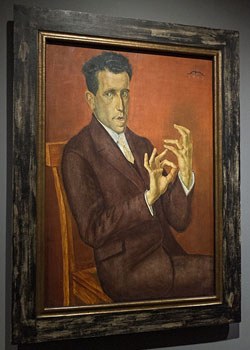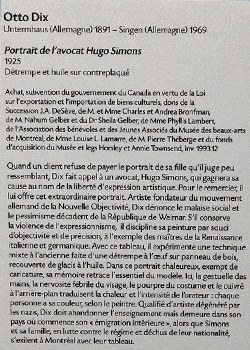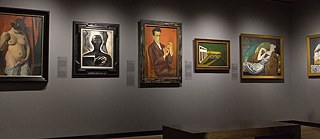The portrait of the lawyer Hugo Simons German Traces in Montreal
The Portrait of the Lawyer Hugo Simons
The Montreal Museum of Fine Arts (Musée des beaux-arts de Montréal) houses an extraordinary treasure in its collection: a portrait of the artist Otto Dix’s lawyer and friend Hugo Simons (1892-1958), which was painted in 1925 in Germany. This piece has three features of particular interest: the unusual painting technique that Dix used for this portrait; the origin story of the work; and its odyssey during the Second World War, from Nazi Germany through Holland to Montreal.
Otto Dix (1891-1969) is undoubtedly one of the most significant modern German painters. His high rank in the international art scene is thanks to his expressionist drawings, gouaches, and oil paintings from before and after World War I, totaling over 600 pieces. He came to fame as part of the Weimar Republic’s “New Objectivity” (Neue Sachlichkeit) movement in the 20s. As a big admirer of northern European Renaissance painters of the 16th century, such as Albrecht Dürer, Hans Baldung Grien, or Hans Holbein, Dix studied the themes and painting techniques of the old masters carefully, often incorporating them into his work. As a result, he gained a prominent status among his artistic colleagues in the Neue Sachlichkeit movement, like George Grosz or Max Beckmann.
Dix painted Hugo Simons’ portrait in 1925 because he was thankful to the lawyer, who had successfully represented him in a lawsuit. Shortly beforehand, a client had asked Dix to paint a portrait of the client’s daughter. However, upon completion of the painting, the client refused to pay for the portrait, claiming that it didn’t look anything like his daughter. The case, which had a happy outcome for Dix, was not only a milestone in the official recognition of artistic freedoms, but was also the beginning of a lifelong friendship between the painter and his lawyer/model. The two became pen pals, even though their relationship was limited by the confusion and hardships of the Second World War.
Dix remained in Germany, where he was hit hard by the power of the Nazis, who banned him from teaching and exhibiting his work. He moved to a small town near Lake Constance (called Bodensee in German) on the Swiss border, where he spent the war and the years immediately following it unemployed and in poverty. Meanwhile, Hugo Simons fled Germany in 1933 with his family and possessions, going to The Hague in Holland. Simons was stateless and without a work permit, but he and his wife dedicated themselves to helping German Jews escape to Holland with great success. In 1939, after much difficulty, they were finally able to get passage to Canada with their three children. The family settled in Montreal, where Hugo Simons supported himself and his family with assorted jobs until his death from cancer in 1958.

On your next visit to the Montreal Museum of Fine Arts, please don’t miss out on seeing this unique piece in person with its incredible story.
Montreal Museum of Fine Arts
1380 Rue Sherbrooke Ouest
Montréal, QC H3G 1J5
